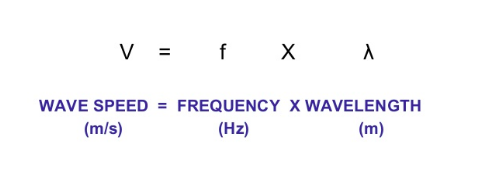Waves
Electromagnetic Waves

⇒ Electromagnetic waves differ to the other types of waves seen (Waves - The Basics), because of instead of vibrating particles, here there are vibrating electric and magnetic fields
- So this is very different to, say, a water wave
⇒ As seen above, there is a whole spectrum of electromagnetic waves, and they obey the same wave equation:

⇒ For electromagnetic waves, the speed will always equal 'c' (the speed of light). The speed of light is about 3 x 108 m/s
- If we increase the wavelength, we have to reduce the frequency.
- So, for example, at the right end of the spectrum we will have a long wavelength meaning the frequency is low.
Different electromagnetic waves
⇒ Radio waves are used for long range communication and have a wave length of about 1 meter to 104 meters
⇒ Microwaves have a wavelength in the centimetre range (about 10-2 meters). These are used for communication with satellites as they pass quite easily through the atmosphere. Other ranges of microwaves are absorbed quite well by water so it can be used to heat up food that has lots of water in it, which is what your microwave does.
- Note, the microwaves your microwave uses is different to the microwaves your phone uses to communicate with satellites, which is why mobile phones are safe and putting your head in the microwave is not safe
⇒ Infrared is about 10-5 meters and includes thermal radiation (e.g. heat lamps) and thermal imaging (e.g. in police helicopters to catch criminals)
⇒ Visible light is the electromagnetic wave you are most familiar with because you see it all the time as it is the one that eyes can detect
- It has a wavelength in the hundreds of nanometers range (10-7 meters)
- Visiblelight is also used in fiber optic cables, where light travels down the cable to communicate
- Note: everything to the right of visible light is known as the red end of the spectrum and everything to the left of visible light is known as the violet end of the spectrum
⇒ Ultraviolet is a type of ionising radiation and has a wavelength of about 10-8 meters. Ultraviolet is what gives you a sun tan
- Ionising radiation means the energy is high enough to knock electrons off atoms, turning them into positive ions. All electromagnetic waves within the violet end are ionising.
- Ionising radiation can be dangerous because one of three things often happens: the cell will die, the cell will fix itself, or the cell will mutate poorly and could become cancerous
⇒ X-rays have a wavelength of 10-10 meters and are used for medical imaging as they pass straight through soft-muscle/skin but is absorbed by bones. It is also ionising, which is why you don't want to have too many x-rays.
⇒ Gamma rays have an extremely short wavelength of 10-15 meters and is even more ionising than x-rays so being exposed to lots of gamma rays can be very bad for you.
- Gamma rays can be used to treat cancer because the ionisation means it will kill all living cells (such as a cancerous tumor) if you shine enough gamma rays at it.
Reflection
⇒ What happens when a wave hits a boundary between two materials? e.g. the boundary between glass and air (a window) or a boundary between air and water (surface of a pond)
⇒ It can do one of three things:
- Reflected
- Transmitted - that means it will go straight through the material. It could be refracted too (see our notes on Refraction)
- Absorbed - if the wave is absorbed it will increase the energy stored in that material. For example, a black object absorbs light and gets very warm in comparison to a white object
Types of Reflection

⇒ Mirror / smooth surface
- If you shine a ray of light at a mirror then it will be reflected (the reflected ray) at the same angle as the incident ray (the ray that bounces off the mirror)
- In other words, the angle of incidence is equal to the angle of reflection
⇒ Rough surface
- If you shine a light ray at a rough surface the angles of reflection work in the same way as a smooth surface, except there are numerous different surface angles so there are numerous different reflections
- This is known as diffuse reflection. In contrast, the reflection from a mirror is known as specular reflection